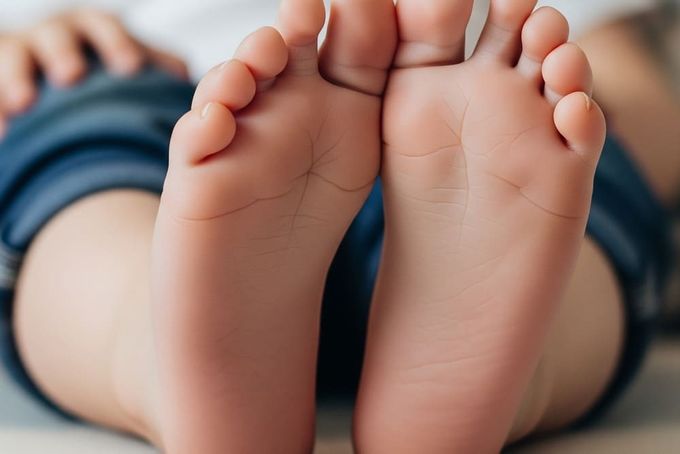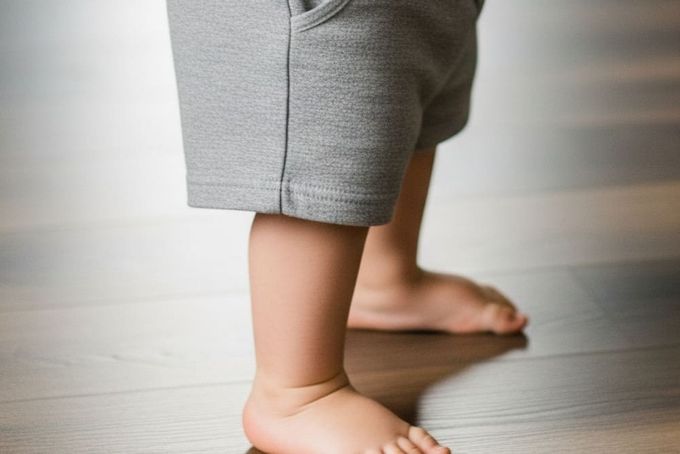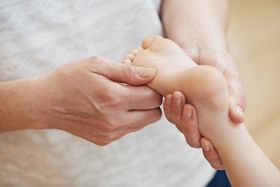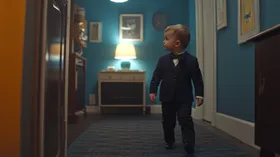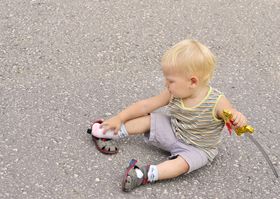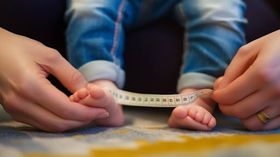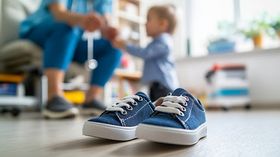Low Arch vs. Flat Feet in Toddlers: A Podiatrist's Perspective
Low arches still have some visible arch, while flat feet look completely flat when standing. Most toddlers develop arches between the ages 2-6, so flat-looking feet are normal in young children.
Published September 6, 2025
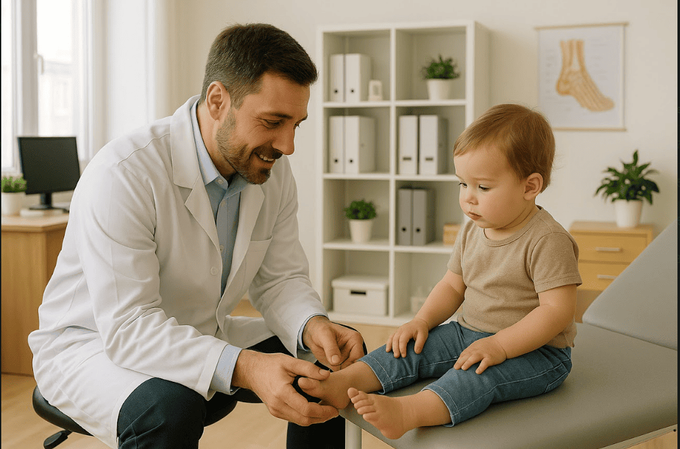
You watch your toddler run across the playground and notice their feet look completely flat against the ground. Your mind starts racing with questions about whether this is normal or if you should be concerned.
The terms "low arches," "flat feet," and "fallen arches" get thrown around a lot, but understanding what each means can save you unnecessary worry. As parents, knowing the difference helps you provide the right support during the different stages of foot development
Understanding Low Arches vs Flat Feet in Toddlers
As a podiatrist with over a year of private practice experience, I see parents struggling to tell the difference between normal foot development and problems that need help.
Low arches still have some arch that you can see, even when your child is standing, though it looks flatter than normal. The foot bends normally, and the arch looks more curved when your child stands on tiptoes.
Flat feet (pes planus) in toddlers show the arch completely or almost completely flattened when standing. In stiff flat feet, the foot stays flat no matter what position it's in, while bendable flat feet may show some arch when your child isn't standing on them.
How Podiatrists Identify Flat Feet or Low Arches
- Looking at your child's feet when they're standing and sitting
- Checking footprints to measure how wide the middle part is compared to the heel
- Having your child stand on tiptoes to see if an arch appears
- Testing how bendable their feet are in different positions
Checking how bendable your child's foot is helps figure out what type of flat feet they have: flexible flat feet show the arch coming back when your child sits down or stands on tiptoes, while stiff flat feet stay flat no matter what position the foot is in.
Symptoms of Low Arches and Flat Feet in Toddlers
Most toddlers with both low arches and flat feet don't show any symptoms, especially when they're young. However, some signs might mean your child needs extra support.
Low Arch Symptoms in Toddlers
- Very mild foot tiredness after lots of running or jumping
- Occasional complaints of foot discomfort during long play sessions
- Slightly less energy during high-impact activities
- Generally pain-free with normal daily activities
Flat Feet Symptoms in Toddlers
- Foot, ankle, or heel pain after running or playing for a long time
- Getting tired faster than other kids during physical activities
- Complaining that their feet hurt during or after sports
- Walking differently or starts limping
- Refusing to walk or wanting to be carried more often
Warning Signs That Need a Doctor's Attention
- Your child cries or complains about foot pain regularly
- They avoid running, jumping, or playing like other kids their age
- You notice them limping or walking strangely
- One foot looks very different from the other
- Pain that doesn't go away with rest
Remember that most toddlers with flat feet or low arches feel completely fine. Pain and problems usually only happen in more serious cases or when the flat feet are stiff rather than bendable.
When Do Toddler Foot Arches Develop Naturally
Your baby's feet are supposed to look flat when they're born because of baby fat in their feet and loose joints. This gradually changes between ages 2 and 6 years as their muscles get stronger [1].
Most toddlers have flat-looking feet until around age 4. This is the most common age group when your toddler's foot arches develop. The arch gets higher as your child's foot muscles get stronger from walking and playing.
When Arch Development Happens
- Birth to 4 Years: Flat-looking feet are completely normal.
- Age 4-6: You'll start seeing arches form in most children.
Flat feet in toddlers that stay flat after age 6, especially if they're stiff or causing pain, might mean there's something else going on that needs checking. [2].
Clinical Example: I recently saw a concerned mother whose 3-year-old had "completely flat feet." After assessment, we found perfectly flexible feet with normal development for his age.
What Causes Low Arches and Flat Feet in Toddlers
Both low arches and flat feet can happen for similar reasons, though some differences exist between them:
- Family History: 40-60% chance if mom or dad has flat feet.
- Loose Joints: Some kids just have bendier joints and muscles.
- Weight and Shoes: Being overweight or wearing bad shoes.
- Born That Way: Some babies are born with different foot shapes.
- Muscle Problems: Issues that affect how strong muscles are.
If one parent has flat feet, there's a good chance your child might get them too. But it might not look the same because of differences in how their arches develop, how strong their muscles are, the shoes they wear when learning to walk, and how active they are.
How Low Arches and Flat Feet Affect Your Toddler's Play
How these foot problems affect your child's activities depends on whether they have low arches or flat feet and how severe the condition is.
For toddlers with low arches, they may:
- Have very little trouble with normal activities
- Get tired slightly faster during really hard play
- Have no pain or discomfort during activities
For toddlers with flat feet, they:
- May have different walking patterns with less push-off power
- Could be slower to learn some movement skills
- Might change how they walk, like turning toes in, which affects balance
Expert's Note: In severe cases, flat feet may limit participation in high-impact activities.
Studies show that up to 25% of children with flat feet that cause problems have pain or discomfort during activities, compared to less than 5% of children with low arches [3].
Toddlers with flat feet who don't have proper arch support may change how they move, which can affect their balance and how long they can play at the playground.
How to Treat Low Arches and Flat Feet
How you help depends on how bad the problem is and whether it's causing your child pain or trouble with activities.
Treatment options for low arches include:
- Watching and maybe using store-bought arch supports if there's discomfort
- Encouraging barefoot play on different surfaces
- Waiting out the important growing years
- Encouraging activities that strengthen foot muscles naturally
To treat flat feet in your toddler:
- Do physical therapy to make the foot muscles stronger and improve how they line up
- Use custom shoe inserts that give arch support
- Start doing exercise programs just for the foot muscles
- Get good footwear with firm arch support and stability features
What treatment you choose depends on how bad your child's condition is, whether it causes symptoms, and how they're developing overall.
What Happens If You Don't Treat Low Arches and Flat Feet
If you don't treat flat feet, your child might have ongoing pain that can spread to their knees, hips, or back.
They may start walking differently, which makes them more likely to get hurt. In severe cases, their foot shape could become permanently changed. As they get older, they might have trouble playing sports or being active.
If you don't treat low arches, there are usually very few long-term problems. Your child might feel some mild discomfort during very long activities, and there's a small chance the low arches could turn into flat feet, but this rarely happens.
Generally, low arches don't cause major problems with daily life or activities. Getting help early and proper treatment are really important to prevent bigger problems, and regular check-ups help figure out what's best for your child's specific situation.
When Do Low Arches and Flat Feet Resolve Naturally
Many toddlers with flat feet get better as they grow up, especially if their feet are bendable and don't hurt.
Flat feet and low arches that usually get better have:
- No pain
- Normal walking patterns without gait abnormalites
- Feet that bend normally and show flexibility
- No signs that the problem is getting worse
- Normal participation in age-appropriate activities
Flat feet that need help usually have:
- Pain that doesn't go away or gets worse
- The problem gets worse over time
- Feet that stay stiff and don't bend properly
- Trouble with normal walking or playing
Regular check-ups with a doctor help figure out when your child needs help versus when natural growing up will fix the problem.
Choosing the Right Footwear for Low Arches and Flat Feet
Shoes for Toddlers With Flat Feet
You need shoes that give strong arch support, cushioning, and stability. The shoes should help control foot movement to prevent too much rolling inward, and have strong heel areas for stability.
Look for shoes deep enough to fit special insoles if your doctor recommends them. Also, make sure they are durable and supportive shoes with enough padding to protect growing foot parts during active play.
Shoes for Toddlers With Low Arches
These kids do well with shoes that have medium arch support and cushioning to provide comfort without over-correcting. Focus on bendable orthopaedic shoes for toddlers that allow natural foot movement while still offering gentle support.
Proper fit remains essential; make sure there's enough room for toes and the heel stays secure without stopping natural foot development.
First Walker Shoes for Low Arches and Flat Feet
First Walker shoes play a vital role in early arch development. For toddlers with flat feet, choosing shoes with adequate arch support can assist in developing proper foot mechanics. It's important to select shoes that are flexible yet supportive to encourage healthy foot development.
Supporting Your Toddler's Foot Development
Understanding the differences between low arches and flat feet helps you make smart choices about your toddler's foot health. Many foot shapes represent normal growing variations rather than problems that need aggressive treatment.
Getting checked early is helpful, especially if flat feet run in your family. Things like being overweight and how your toddler's shoes fit can make problems worse, even in kids who are likely to get them anyway.
The key is proper watching, good shoe choices like First Walkers Orthopaedic range, and understanding that natural development takes time.
References
Babu, D., & Bordoni, B. (2024, September 10). Anatomy, bony pelvis and lower limb: medial longitudinal arch of the foot. StatPearls - NCBI Bookshelf. https://www.ncbi.nlm.nih.gov/books/NBK562289/
Halabchi, F., Mazaheri, R., Mirshahi, M., & Abbasian, L. (2013, June 1). Pediatric flexible flatfoot; clinical aspects and algorithmic approach. https://pmc.ncbi.nlm.nih.gov/articles/PMC3684468/
Xu, L., Gu, H., Zhang, Y., Sun, T., & Yu, J. (2022). Risk Factors of Flatfoot in Children: A Systematic Review and Meta-Analysis. International Journal of Environmental Research and Public Health, 19(14), 8247. https://pmc.ncbi.nlm.nih.gov/articles/PMC9319536/
Disclaimer: First Walkers' information is intended for educational and informational purposes related to toddler footwear and feet. We encourage you to consider individual circumstances and consult qualified orthopaedists about specific conditions.
FAQs
At what age should I be concerned about my toddler's flat feet?
Concern typically arises if flat feet persist beyond age 6, especially if they're rigid, painful, or affecting your child's activity levels. Before age 4, flat-appearing feet are usually normal developmental variations.
Can exercises help my toddler develop arches naturally?
Yes, activities that strengthen foot muscles like toe curls, heel raises, and balance exercises can support natural arch development. However, most healthy toddlers develop arches naturally through normal play and movement.
Will my toddler's low arches or flat feet affect their sports participation?
Most children with low arches or flexible flat feet can participate fully in sports. Symptomatic cases may benefit from supportive footwear or orthotics to enhance comfort and performance.
Should I use special insoles for my toddler's flat feet?
Custom orthotics are typically reserved for symptomatic cases causing pain or functional limitations. Many children benefit more from appropriate footwear and natural development time than from early orthotic intervention.
When should I seek professional evaluation for my toddler's feet?
Seek evaluation if you notice persistent pain, unusual walking patterns, frequent falling, activity limitations, or if flat feet remain rigid beyond age 6. Early assessment helps distinguish normal development from conditions requiring intervention.
